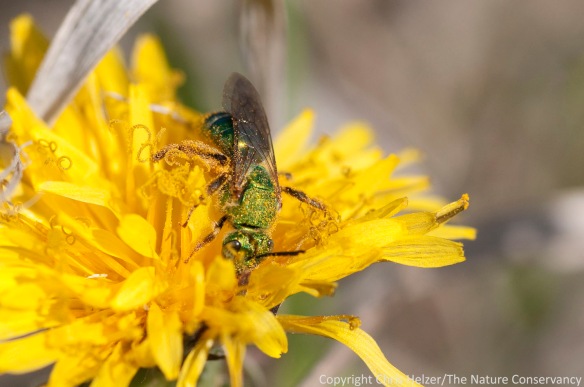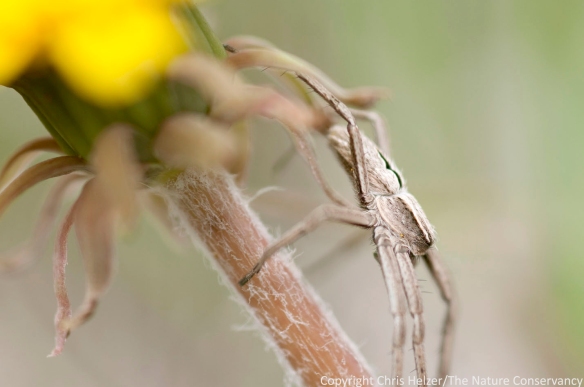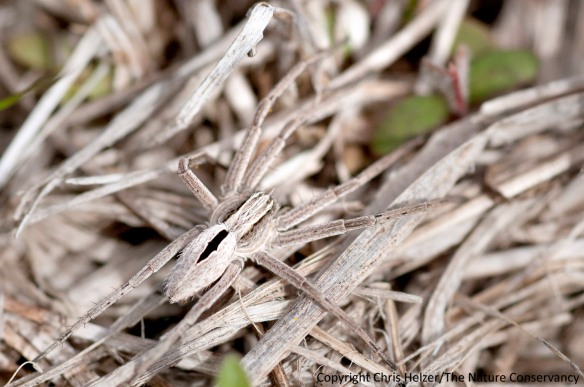I took my boys to our family’s prairie today. I was only intending to stay for a little while, but they were having so much fun building forts in the trees and drawing pictures in the mud, we stayed for several hours. Since they were entertaining themselves, I took a walk to see what was blooming.
Because of the late spring, I only found three wildflower species in bloom. Ground plum (aka buffalo pea or Astragalus crassicarpus) was going strong, and there were a few pussy toes (Antennaria neglecta) getting started. But the most abundant flower was the good ol’ dandelion. While the non-native yard weed is disliked by many people, it was certainly popular with many bees and flies who didn’t have many other options for pollen and nectar sources today.

A sweat bee enjoying a pollen-loaded dandelion at the Helzer prairie south of Aurora, Nebraska. It’s ALMOST sharp enough to be a good photo.
I tried a few times to photograph bees and flies visiting dandelions, but most were too wary to let me get very close. The light was pretty harsh anyway, and the bees certainly weren’t going to let me pull out my diffuser (2 ft diameter thin-cloth-covered circle) before they zipped away. I did finally manage to find one bee so focused on pollen that I got one nearly decent photo before it noticed me. Most of the time, however, the pollinators left before I got anywhere close.
As I approached one flower, the small bee on it flew away, but I noticed something else still on the flower. When I got close enough, I realized it was a spider – apparently hoping to make a meal of the bee I’d inadvertently chased away. While I felt a little bad about that, I thought maybe the spider would make a more accomodating photo subject, so I got out my diffuser and tripod to see what I could do. The spider scooted off the top of the dandelion flower when I got close, but it only retreated as far as the stem of the flower, so I did get a few shots of it there.

A spider on a dandelion flower stem. Moments before it had been stalking a small bee on top of the flower, but a clumsy photographer scared the bee away.
The spider then (very quickly) scuttled a few inches away from the flower and stopped again. If I hadn’t seen it move, it would have disappeared completely against the background of the identically-colored prairie thatch. Beautiful camouflage!
I sure wish I’d gotten to see the spider try for that bee. I’m not sure what kind of spider it was, but it certainly wasn’t a crab spider, which is what I typically see hunting on flowers. This one looked more like an active hunting spider (similar to a wolf spider) than a nearly blind ambush spider (such as a crab spider). I’m guessing prey isn’t overly abundant at this time of year, and its probably hard to turn down an opportunity to hunt in one of the few places you’re pretty sure to find it.
Dandelions might not be everyone’s favorite flower, but I’m sure glad to have them in my prairie in the early spring. Apparently, so are quite a few bees and flies – and at least one enterprising spider!


Beautiful shots! I think the spider may be a Philodromid in the genus Thanatus. I found one several years ago in the Okanagan Valley.
http://bugguide.net/node/view/200216
As always, it’s great to hear about your up-close encounters and outcomes with tiny occupants of the prairie. Here in west central Illinois, prairie is also slow to be revived from the extensive winter. I’m hoping that this spring’s extra rain will produce at least a “normal” prairie, compared with 2012’s lack of rain. Your blogs often remind me that prairies aren’t just what can be observed by standing up and looking to the distance.
it’s so great to see the spider against different backgrounds. i always enjoy your posts.
Dandelion greens also make a good addition to spring salad! In Cook County IL by the Des Plaines River, savanna species are a little slow after a cold spring and flooding caused by yet another record-setting inundation (after our epic drought last year). Yesterday I saw some sweat bees (I think) in a patch of vinca I keep in my back yard purely for the early bloom that bees need. Your photos help me with observation and identification.
Love the bug shots. I was able to get a good close up of a crab spider that grabbed a small be in a pasque flower this weekend.
Good for you! I wish I had pasque flowers around here. For that matter, I wish I had crab spiders around here, at the moment! I’m sure they’re around, but I’ve not seen one yet this spring.
I was a bit surprised too, especially since I was able to get the prairie burned in February. I thought there might be some impacts on invertebrates, but life appears pretty normal. Interestingly, the pasque flowers seem to be browsed a little more than I’ve seen in the past. I have quite a few deer, but I wonder whether they are spending more time on the ridges because they have been burned and there is more fresh greens than usual.
Very interesting! I wouldn’t be surprised that the deer are responding to the burn. We tried studying that once, but didn’t get very far…
I took my 6 year old boy out this Sunday to help Stephen Packard and the Spring Creek Stewards plant plugs. My son did not want to come until I promised him he would get to see a snake. I was sweating that promise, but did not need to worry. We saw well over 20 Chicago and Plains Garter snakes. My son proudly even found one by himself. It was one of the biggest of the day. After seeing his sixth snake the novelty wore off. My son began telling everyone knock knock jokes that did not make any sense, but that he found profusely funny. I don’t think my son stopped talking for the entire three and a half hours that we were at the site. Yet, I do not think the people volunteering minded too much at all. My son is a fun little guy.
James
Pingback: Photo of the Week – May 2, 2013 | The Prairie Ecologist
Sent your spider photo to an arachnologist friend in Kansas who responded:
The spider is a species of Thanatus (Philodromidae), probably T. formicinus. The general shape and the prominent heart mark are good characters for the genus. They are not overly abundant when collecting by sweeping, probably because they live lower down in the dead grass layer, but they can be found on shrubs and trees. Probably are similar to wolf spiders behaviorally, as the author surmised, but have scopulae enabling them to ascend arboreally as well. All philodromids are both sit and wait and cursorial hunters. One species (T. vulgaris) has become well established in cricket colonies and is often imported from commercial cricket farms, but doesn’t seem to become well established in the north.
By the way, the author refers to “blind” crab spiders. Actually crab spiders (Thomisidae) have pretty good vision.
Thanks Robert! Great info.
I’ve enjoyed the dandelion both as a the flower and the seeded head. Yes, I know many consider them a nuisance in the yard. But, those same people will enjoy a large field of them.
Pingback: 20 Photos of Land Animal Camouflage – Mind Bomb #017 | OKJ Discoveries
Pingback: Photo of the Week – July 7, 2016 | The Prairie Ecologist